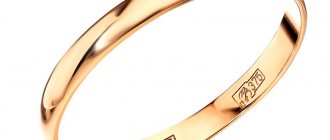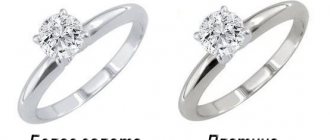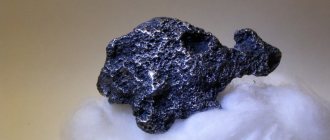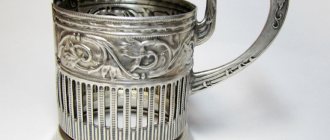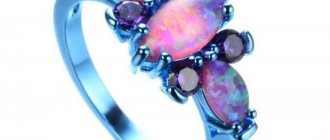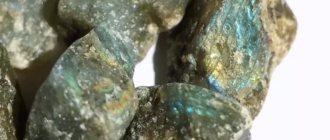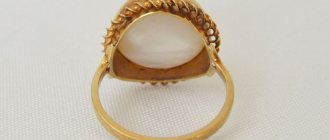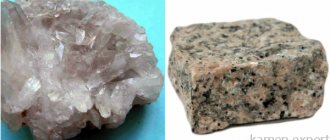Chemical composition of platinum
Pure platinum is very rare. Native platinum as a type is a solid solution containing more than 50% Pt (80–88%) with a metal of the same or other groups, mainly iron. Hence the original name of ordinary platinum, polyxenes (Greek for “receiving many guests”). The fusion (formation of solid solutions) of platinum metals is due to the proximity of their atomic radii, caused by “lanthanide compression”.
Most samples are represented by the ferrous variety (polyxene), and often by intermetallic compounds: isoferroplatinum (Pt,Fe)3Fe and tetraferroplatinum (Pt,Fe)Fe. Platinum, represented by polyxene, is the most common mineral of the platinum subgroup in the earth's crust. Fe is constantly present - up to 9.2% (in isoferroplatinum), sometimes reduced to 4–5% (the Pt content also changes accordingly). Of other isomorphic impurities, the following are established: Pd - 0.1–2.0%, sometimes up to 21% - palladium platinum; Ir - up to 7% - platinum iridide; Rh - 0.1–0.5%, sometimes up to 4–5% - native platinum; Cu - up to 0.8%; Ni - traces up to tenths of a percent, sometimes in very significant quantities - nickel platinum.
Varieties:
- ferroplatinum containing 10-30% Fe;
- cuproplatinum with 14% Cu;
- norilskite with 25% Fe and 26% Ni;
- nickel-platinum containing about 3% Ni;
- palladium platinum with 7-40% Pd;
- platinum iridium containing up to 70% 1g;
- native platinum with 5% Rh.
Zodiac sign
- Ideal for water signs of the zodiac - Pisces and Cancer . They can wear platinum jewelry all the time. The decoration will become a suitable talisman.
- A similar decoration will also come in handy for Sagittarius . It will help him find peace of mind and achieve harmony. For Scorpio, platinum jewelry will develop intuition.
- You should be wary of metal for Gemini , Leo , as well as Aquarius and Taurus .
- Virgos can wear the product on rare occasions when they need to calm down and get rid of negative thoughts.
- Read more about each zodiac sign here .
Crystallographic characteristics
system ; hexaoctahedral c. With. 3L44L36L29PC. Space group Fm3m (O5h). a0 = 3.9158. a0 = 3.924 A (pure Pt), 3.831 A (pure Ir), Z = 4
The crystal structure is close-packed cubic - atoms at the sites of a face-centered cubic lattice (Cu type).
The appearance of crystals. In combinations of faces, in addition to the dominant form {100}, {110}, {210}, {310} and some others are observed. Of the twins, twins of germination along (100) and fusion along (111) are predominantly developed. Polyxene crystals of skeletal development are known.
Form of being in nature
Usually observed in the form of small grains or nuggets weighing up to 8 kg. The largest nugget found in the primary deposits of the Urals weighed 427.5 g. Nuggets found in placers reached a size of 10 × 18 cm and a weight of 8–9 kg. The largest platinum nuggets displayed at the exhibition of the Diamond Fund of Russia weigh 5918.4 and 7860.5 grams. The rare small crystals are mostly cubic in shape.
Individual grains of native platinum found in ores are often grouped into small piles, sometimes forming continuous masses - nuggets.
This is interesting
Platinum is a curious, rare metal. Often it falls from the sky, like a gift from outer space. There are a lot of interesting facts associated with metal:
- To get just 15 grams of platinum, you have to process 5 tons of ore.
- Platinum is 30 times more expensive than gold.
- In the 19th century, standards for measuring quantities: meters and kilograms were made from an alloy of iridium and Pt.
- In 1843, a huge ingot was discovered in the Urals. His weight was more than 9.5 kilograms. Unfortunately, the sample has not survived. It was melted down.
- The largest nugget that has survived was also found in the Urals. Weight – 7.869 kg. It is kept in the Russian treasury - the Diamond Fund.
- Marlene Dietrich introduced into fashion inconspicuous jewelry made from Pt. This happened in the 30s of the last century.
- The antioxidant properties of the metal are used in cosmetology. As a result, the skin becomes smoother and wrinkles disappear.
- Pt is used for the manufacture of catalytic converters. The equipment absorbs harmful substances that are released during emissions from cars.
- Platinum began to be considered a precious metal only in the mid-18th century. Before this, the element was used only to reduce the price of jewelry. Moreover, Ural hunters even made shot for cartridges from “worthless silver.”
- During the Soviet era, metal was used to make award badges.
Fortunately, over time, the positive properties of the metal are appreciated. Now it is valued more than gold.
Physical properties of platinum
Optical
- The color is steel gray to silver white with a yellow tint (platinum iridium) polyxene is silver white to steel black.
In polished sections, white, isotropic.
- The line is metallic, steel-gray.
- The shine is typical metallic.
Mechanical
Hardness is 4–4.5, for varieties rich in iridium – up to 6–7. There is no cleavage; the fracture is splintered, hooked. Ud. V. 21.5 (pure Pt); for platinum minerals less.—15–19. A connection between the reduced specific gravity and the presence of voids occupied by natural gases, as well as inclusions of foreign minerals, has been noted.
Other properties
Platinum iridium has a TV. 6-7, beats. V. 22.66, etc. 2360° S.
Chemical properties. Insoluble in acids (except aqua regia). T. pl. 1774° N.
Other properties . Pure platinum is non-magnetic, but such grains are extremely rare. Polyxene is magnetic, tetraferroplatinum is highly magnetic. Conducts electricity well. Very ductile (i.e. malleable and stretchy); for example, from 1 g of pure platinum you can draw a wire about 500 km long.
Diagnostic signs. In appearance, polyxene most closely resembles native silver and native iron. It differs from the first by its increased hardness, specific gravity and the fact that it does not melt under the blowing tube and does not dissolve in acids (except for aqua regia). Its insolubility in acids also distinguishes it from native iron.
How to distinguish platinum from other metals
From silver
The most common item given out under the guise of an expensive metal is silver. Here are a few criteria to consider when choosing platinum jewelry that will help determine the authenticity of the platinum.
- Hue. The original will always be lighter and whiter than silver. If your platinum jewelry has darkened over time, it is most likely sterling silver.
- Silver is much lighter. Their weight varies significantly. Jewelry of the same size will always weigh differently.
- Density. This indicator for white metal is one of the highest among others, so it is not susceptible to almost any mechanical influence.
- Temperature resistance. Platinum is much more resistant to high temperatures. For example, if you bring it to an open fire, nothing will happen to it. Silver heats up very quickly and takes on ambient temperature. This can be checked by even holding the product under hot water for several minutes.
How to distinguish platinum from white gold
Less often, white gold is given out under the guise of an expensive metal. An important difference, which unfortunately cannot be checked when purchasing, is that white gold is an alloy of several metals. As a rule, these are nickel, palladium, silver and yellow gold itself.
In the case of white gold, one of the elements added to it can cause allergies. Platinum, unlike white gold, does not cause allergies.
Again, don't forget to make sure you have a sample. The fineness values for platinum and white gold are different. For gold it is 500, 585, 750, and for white metal it is 850, 900, 950.
Gold is easily subject to mechanical stress. It is easy to scratch or leave marks on it. Platinum has a very high density, so this shouldn’t happen to it.
The weight, as in the case of silver, is very different. Platinum is much heavier.
White gold, although it has this name, still has different shades. This occurs due to the presence of certain elements in the alloy. Platinum jewelry always has a noble white tint. The only shade very similar to precious metal is the rhodium plating. It shines beautifully and also has a white undertone, which makes it almost impossible to visually distinguish it from its more expensive relative. However, over time, this coating begins to wear off and needs to be renewed.
The difference is also in cost. Products made from premium metal will never cost less than white gold.
From stainless steel
Stainless steel is very difficult to distinguish. In the question of how to determine platinum, methods that work for other metals will not help. Pay attention to the price. Steel will cost much less. There will be no markings on steel, while platinum jewelry will always have one.
Otherwise, it is possible to distinguish stainless steel from platinum only in the laboratory by taking physical measurements.
Origin
Found in primary deposits or placers. The former are of two types: a) inclusions or local impregnations of native platinum in ultrabasic igneous rocks (dunites) associated with chromite and b) copper-nickel sulfide accumulations in basic (norite) rocks. In basic magmas, at temperatures of 1300–1500° C, sulfides separate from the silicate melt. Chromite, osmium, iridium and platinum separate at higher temperatures; palladium is at the same or lower temperature and is thus captured in the sulfide melt. Therefore, native platinum and osmiride are the main minerals in the first type of deposits. The second type contains a lot of palladium and platinum, often found in the form of arsenide (sperrylite).
Contact-metamorphic platinum deposits, as well as quartz veins containing platinum, are also known.
Platinum group minerals are mostly found in typical igneous deposits genetically related to ultramafic igneous rocks. These minerals are among the last to be released in ore bodies (after silicates and oxides) at moments corresponding to the hydrothermal stage of the magmatic process.
Platinum minerals poor in palladium (polyxene, platinum iridium, etc.) are found in deposits among dunites - olivine feldspathic rocks rich in magnesia and poor in silica. Moreover, paragenetically they are extremely closely related to chrome spinels - oxides of complex composition: (Fe,Mg)(Cr,Al,Fe)2O4.
Palladium and nickel-palladide platinum are predominantly common in basic igneous rocks (norites, gabbro-norites) and are usually associated with sulfides: pyrrhotite (Fe1-XS), chalcopyrite (CuFeS2) and pentlandite - (Fe,Ni)9S8.
Under exogenous conditions, in the process of destruction of bedrock deposits and rocks, platinum placers are formed. Most of the minerals of the subgroup are chemically resistant under these conditions.
Healing and magical properties
Platinum nanoparticles can easily penetrate into the cells of the human body and have a beneficial effect on metabolic processes occurring in the body. One of the main functions of the mineral is the destruction of free radicals and inhibition of premature aging. Some drugs used in the treatment of cancer contain platinum.
The metal has also found other uses in medicine:
- The mineral is used in the production of surgical instruments, which are sterilized in the flame of an alcohol burner. Platinum alloys containing silver, palladium, copper, zinc or nickel are excellent materials for the manufacture of dentures.
- The metal, due to its inertness to various compounds, electrical conductivity and hypoallergenicity, is actively used as a component of electrical stimulators, catheters and other types of medical equipment.
It is also worth noting the magical properties of the noble mineral. He is considered light, pure and devoid of evil. Platinum does not retain negative memories like gold. She is closely connected with the cosmos and brings wisdom and goodness to people. The material helps to illuminate the soul and enlighten the mind. Medical workers are recommended to wear a talisman made from this metal. Silver metal is also suitable for those whose activities are related to people who need help.
Platinum products are able to neutralize negative emotions and awaken positive thoughts in a person, sharpen intuition, and show their owner the right path or decision. A metal amulet will protect a person from negative influences that destroy the energy shell.
Platinum can soften the effect of precious stones. It is often used as a setting for those gems that can greatly affect their owners and cause them harm. Metal is recommended for people who want to take the path of spiritual enlightenment and turn to religious or occult teachings. When praying or meditating, it is recommended to wear a platinum ring on your index or ring finger.
The strength of the metal is also considered a magical property. Some believe that if newlyweds exchange platinum rings at a wedding, then they will be together for the rest of their lives. Durable amulets will not allow anyone or anything to separate a couple in love.
The mineral should be purchased only by calm natures prone to contemplation. Metal does not like gossipers and envious people, and it can severely punish thieves and traitors.
Platinum is associated with the planet Neptune. This metal is indicated for Pisces and Cancer. Some ancient Indian tribes worshiped platinum bars. People believed that Neptune himself heard them through the mineral.
Place of Birth
Large deposits of the first type are known near Nizhny Tagil in the Urals. Here, in addition to primary deposits, there are also rich eluvial and alluvial placers. Examples of deposits of the second type are the Bushveld igneous complex in South Africa and Sudbury in Canada.
In the Urals, the first discoveries of native platinum that attracted attention date back to 1819. There it was discovered as an admixture to placer gold. Independently rich platinum placers, which are world famous, were discovered later. They are common in the Middle and Northern Urals and are all spatially confined to outcrops of massifs of ultrabasic rocks (dunites and pyroxenites). Numerous small primary deposits have been established in the Nizhny Tagil dunite massif. Accumulations of native platinum (polyxene) are confined mainly to chromite ore bodies, consisting mainly of chrome spinels with an admixture of silicates (olivine and serpentine). From the heterogeneous ultramafic Konder massif in the Khabarovsk Territory, platinum crystals of cubic habit, about 1–2 cm in size, come from the edge. A large amount of palladium platinum is mined from segregation sulfide copper-nickel ores of the Norilsk group deposits (North Central Siberia). Platinum can also be extracted from late magmatic titanomagnetite ores associated with the main rocks in such deposits as, for example, Gusevogorskoye and Kachkanarskoye (Middle Urals).
An analogue of Norilsk is of great importance in the platinum mining industry - the famous Sudbury deposit in Canada, from whose copper-nickel ores platinum metals are extracted along with nickel, copper and cobalt.
What stones and metals is it compatible with?
This is a great option to pair with gold and silver. The product looks elegant and stylish. In addition, Platinum enhances the properties of neighboring precious metals. As a rule, the element is not combined with non-precious alloys.
In the classic version, diamonds are set in platinum. The stone opens up and looks even brighter, the metal enhances its magical and healing characteristics.
Platinum frames are also suitable for:
- sapphires;
- amethysts;
- aquamarines;
- Labradors
Such products are highly valued in the jewelry market; purchasing jewelry becomes a profitable investment.
Practical use
During the first period of mining, native platinum did not find proper use and was even considered a harmful admixture to placer gold, with which it was caught along the way. At first, it was simply thrown into a dump when panning for gold or used instead of shot when shooting. Then attempts were made to falsify it by gilding it and handing it over to buyers in this form. Among the very first products made from Ural native platinum, stored in the St. Petersburg Mining Museum, were chains, rings, hoops for barrels, etc. The remarkable properties of platinum group metals were discovered somewhat later.
The main valuable properties of platinum metals are infusibility, electrical conductivity and chemical resistance. These properties determine the use of metals of this group in the chemical industry (for the manufacture of laboratory glassware, in the production of sulfuric acid, etc.), electrical engineering and other industries. Significant quantities of platinum are used in jewelry and dentistry. Platinum plays a critical role as a catalyst surface material in oil refining. The mined “raw” platinum is sent to refineries where complex chemical processes are carried out to separate it into its constituent pure metals.
Where is platinum used?
Vacheron Constantin watches in platinum
Today, platinum is widely used in the production of jewelry, in particular, to create wedding rings and fine jewelry.
Advertising - Continued below
In addition, platinum is actively used in the chemical and electronics industries, as well as for the manufacture of electrical contacts and vessels for melting optical glass. In medicine, platinum compounds are used to fight cancer and in the dental field.
Production
Platinum is one of the most expensive metals, its price is 3-4 times higher than gold, and about 100 times higher than silver
Platinum production is about 36 tons per year. The largest amounts of platinum are mined in Russia, South Africa, Kaiada, the USA and Colombia.
In Russia, platinum was first found in the Urals in the Verkh-Isetsky district in 1819. When washing gold-bearing rocks, white shiny grains were noticed in the gold, which did not dissolve even in strong acids. Bergprober of the laboratory of the St. Petersburg Mining Corps V.V. Lyubarsky examined these grains in 1823 and found that “the mysterious Siberian metal belongs to a special kind of raw platinum containing a significant amount of iridium and osmium.” In the same year, the highest order was issued to all mining chiefs to look for platinum, separate it from gold and present it to St. Petersburg. In 1824-1825, pure platinum placers were discovered in the Gorno-Blagodatsky and Nizhne-Tagil districts. And in the following years, platinum was found in several more places in the Urals. The Ural deposits were exceptionally rich and immediately brought Russia to first place in the world in the production of heavy white metal. In 1828, Russia mined an amount of platinum that was unheard of at that time - 1550 kg per year, about one and a half times more than was mined in South America for all the years from 1741 to 1825.
How to check the authenticity of platinum at home
Platinum has a pure white luster that is unlike any other metal. Silver of even the highest standard will have a grayish tint.
Do you think it is necessary to distinguish platinum yourself? Here are several ways to test platinum.
Ammonia or ammonia
Ammonia is easy to obtain at any pharmacy. Ammonia will not react with metal, unlike others that leave dark stains. If no reaction occurs, you are the happy owner of a real jewel.
Iodine
Contact with iodine will cause a dark spot to appear on the platinum. It can be easily removed immediately after the experiment. The darker the color of the spot, the higher the grade of the metal.
Salt
Salt will also come to the rescue if you need to check the authenticity of the jewelry. This experiment will require a little work. You will need:
- can;
- batteries;
- salt and water solution.
Pour the solution into a jar and place the decoration in it. The plus batteries must be connected to the product, and the minus batteries must be connected to the jar. If sediment forms and the liquid becomes cloudy, you are dealing with a fake. If the water remains clear, everything is fine. If you smell chlorine, don't be alarmed. This is the result of the reaction. You have the original in your hands.
Magnet
This method is the least effective, but also has a right to life. Like other noble metals, platinum is not attracted to magnets. This will protect you from crude counterfeiting, but it will not be possible to distinguish silver from platinum in this way.
Platinum. Stories and legends
Humanity has been familiar with platinum for more than two centuries. It was first noticed by members of the expedition of the French Academy of Sciences sent by the king to Peru. Don Antonio de Ulloa, a Spanish mathematician, was the first to mention it while on this expedition in his travel notes published in Madrid in 1748: “This metal has remained completely unknown since the beginning of the world until now, which is without a doubt very surprising.”
Platinum appears under the names “White Gold” and “Rotten Gold” in the literature of the 18th century. This metal has been known for a long time; its white, heavy grains were sometimes found during gold mining. It was assumed that it was not a special metal, but a mixture of two known metals. But they could not be processed in any way, and therefore platinum was not used for a long time. Until the 18th century, this most valuable metal, along with waste rock, was thrown into dumps. In the Urals and Siberia, grains of native platinum were used as shot for shooting. And in Europe, dishonest jewelers and counterfeiters were the first to use platinum.
In the second half of the 18th century, platinum was valued at half that of silver. It alloys well with gold and silver. Taking advantage of this, platinum began to be mixed with gold and silver, first in jewelry, and then in coins. Having learned about this, the Spanish government declared war on platinum “damage”. The Kopolevsky decree was issued, which ordered the destruction of all platinum mined along with gold. In accordance with this decree, officials of the mints in Santa Fe and Papayan (Spanish colonies in South America) solemnly, in front of numerous witnesses, periodically drowned the accumulated platinum in the Bogota and Cauca rivers. Only in 1778 this law was repealed, and the Spanish government itself began to mix platinum into gold coins. It is believed that the Englishman R. Watson was the first to obtain pure platinum in 1750. In 1752, after research by G. T. Schaeffer, it was recognized as a new metal. In the 70s of the 18th century, the first technical products from platinum (plates, wire, crucibles) were made.
How to choose the right platinum
Platinum today is an expensive precious metal that is widely used in jewelry. It has external similarities with white gold and silver. Silver can often be passed off as platinum. Especially if you buy metal secondhand. It is advisable to make such purchases in trusted jewelry stores. But you shouldn’t let your guard down there either. It is almost impossible to visually distinguish platinum from a fake, but there are some nuances that you should definitely pay attention to.
Due to the high cost of metal, jewelry made from it is rarely massive. Most likely, these are neat, miniature products. Also pay attention to the ability to heat up. Try warming the jewelry in your palms for a few minutes. If it does not take your body temperature, then you are dealing with the original.
Be sure to look at the presence of the sample (850, 900, 950, 999) and at the data indicated on the tag or in the so-called product passport. Under no circumstances agree to purchase jewelry without these attributes.
